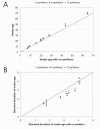Molecular phylogeny and divergence times of Malagasy tenrecs: influence of data partitioning and taxon sampling on dating analyses
- PMID: 18377639
- PMCID: PMC2330147
- DOI: 10.1186/1471-2148-8-102
Molecular phylogeny and divergence times of Malagasy tenrecs: influence of data partitioning and taxon sampling on dating analyses
Abstract
Background: Malagasy tenrecs belong to the Afrotherian clade of placental mammals and comprise three subfamilies divided in eight genera (Tenrecinae: Tenrec, Echinops, Setifer and Hemicentetes; Oryzorictinae: Oryzorictes, Limnogale and Microgale; Geogalinae:Geogale). The diversity of their morphology and incomplete taxon sampling made it difficult until now to resolve phylogenies based on either morphology or molecular data for this group. Therefore, in order to delineate the evolutionary history of this family, phylogenetic and dating analyses were performed on a four nuclear genes dataset (ADRA2B, AR, GHR and vWF) including all Malagasy tenrec genera. Moreover, the influence of both taxon sampling and data partitioning on the accuracy of the estimated ages were assessed.
Results: Within Afrotheria the vast majority of the nodes received a high support, including the grouping of hyrax with sea cow and the monophyly of both Afroinsectivora (Macroscelidea + Afrosoricida) and Afroinsectiphillia (Tubulidentata + Afroinsectivora). Strongly supported relationships were also recovered among all tenrec genera, allowing us to firmly establish the grouping of Geogale with Oryzorictinae, and to confirm the previously hypothesized nesting of Limnogale within the genus Microgale. The timeline of Malagasy tenrec diversification does not reflect a fast adaptive radiation after the arrival on Madagascar, indicating that morphological specializations have appeared over the whole evolutionary history of the family, and not just in a short period after colonization. In our analysis, age estimates at the root of a clade became older with increased taxon sampling of that clade. Moreover an augmentation of data partitions resulted in older age estimates as well, whereas standard deviations increased when more extreme partition schemes were used.
Conclusion: Our results provide as yet the best resolved gene tree comprising all Malagasy tenrec genera, and may lead to a revision of tenrec taxonomy. A timeframe of tenrec evolution built on the basis of this solid phylogenetic framework showed that morphological specializations of the tenrecs may have been affected by environmental changes caused by climatic and/or subsequent colonization events. Analyses including various taxon sampling and data partitions allow us to point out some possible pitfalls that may lead to biased results in molecular dating; however, further analyses are needed to corroborate these observations.
Figures




Similar articles
-
Molecular evidence for the monophyly of tenrecidae (mammalia) and the timing of the colonization of Madagascar by Malagasy Tenrecs.Mol Phylogenet Evol. 2002 Mar;22(3):357-63. doi: 10.1006/mpev.2001.1055. Mol Phylogenet Evol. 2002. PMID: 11884160
-
Multiple Loci and Complete Taxonomic Sampling Resolve the Phylogeny and Biogeographic History of Tenrecs (Mammalia: Tenrecidae) and Reveal Higher Speciation Rates in Madagascar's Humid Forests.Syst Biol. 2016 Sep;65(5):890-909. doi: 10.1093/sysbio/syw034. Epub 2016 Apr 21. Syst Biol. 2016. PMID: 27103169
-
Placental diversity in malagasy tenrecs: placentation in shrew tenrecs (Microgale spp.), the mole-like rice tenrec (Oryzorictes hova) and the web-footed tenrec (Limnogale mergulus).Placenta. 2007 Jul;28(7):748-59. doi: 10.1016/j.placenta.2006.10.003. Epub 2006 Nov 17. Placenta. 2007. PMID: 17113148
-
Mammal madness: is the mammal tree of life not yet resolved?Philos Trans R Soc Lond B Biol Sci. 2016 Jul 19;371(1699):20150140. doi: 10.1098/rstb.2015.0140. Philos Trans R Soc Lond B Biol Sci. 2016. PMID: 27325836 Free PMC article. Review.
-
Major Revisions in Pancrustacean Phylogeny and Evidence of Sensitivity to Taxon Sampling.Mol Biol Evol. 2023 Aug 3;40(8):msad175. doi: 10.1093/molbev/msad175. Mol Biol Evol. 2023. PMID: 37552897 Free PMC article. Review.
Cited by
-
Insights into the evolution of a cryptic radiation of bats: dispersal and ecological radiation of Malagasy Miniopterus (Chiroptera: Miniopteridae).PLoS One. 2014 Mar 18;9(3):e92440. doi: 10.1371/journal.pone.0092440. eCollection 2014. PLoS One. 2014. PMID: 24642892 Free PMC article.
-
Jaw shape and mechanical advantage are indicative of diet in Mesozoic mammals.Commun Biol. 2021 Feb 23;4(1):242. doi: 10.1038/s42003-021-01757-3. Commun Biol. 2021. PMID: 33623117 Free PMC article.
-
Morphological diversity in tenrecs (Afrosoricida, Tenrecidae): comparing tenrec skull diversity to their closest relatives.PeerJ. 2015 Apr 30;3:e927. doi: 10.7717/peerj.927. eCollection 2015. PeerJ. 2015. PMID: 25945316 Free PMC article.
-
A molecular phylogeny of Plesiorycteropus reassigns the extinct mammalian order 'Bibymalagasia'.PLoS One. 2013;8(3):e59614. doi: 10.1371/journal.pone.0059614. Epub 2013 Mar 26. PLoS One. 2013. PMID: 23555726 Free PMC article.
-
Nomenclature and placental mammal phylogeny.BMC Evol Biol. 2010 Apr 20;10:102. doi: 10.1186/1471-2148-10-102. BMC Evol Biol. 2010. PMID: 20406454 Free PMC article.
References
-
- Waddell PJ, Kishino H, Ota R. A phylogenetic foundation for comparative mammalian genomics. Genome Inform. 2001;12:141–154. - PubMed
-
- Bronner GN, Jenkins PD. In: Mammal species of the world. Wilson DE, Reeder DM, editor. Baltimore: Johns Hopkins University Press; 2005. Order Afrosoricida; pp. 71–77.
Publication types
MeSH terms
LinkOut - more resources
Full Text Sources
Research Materials
Miscellaneous

